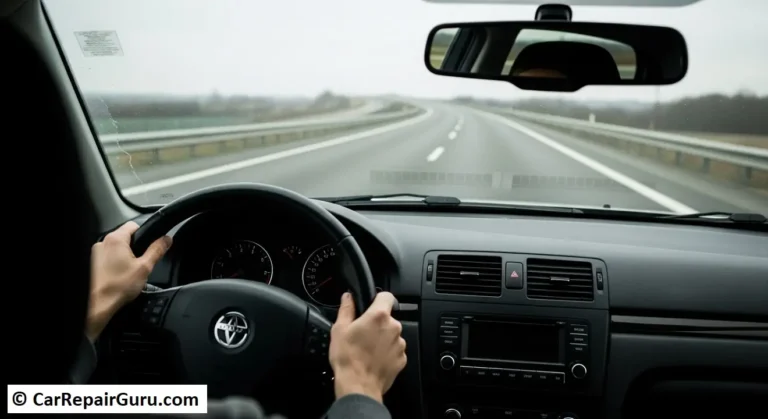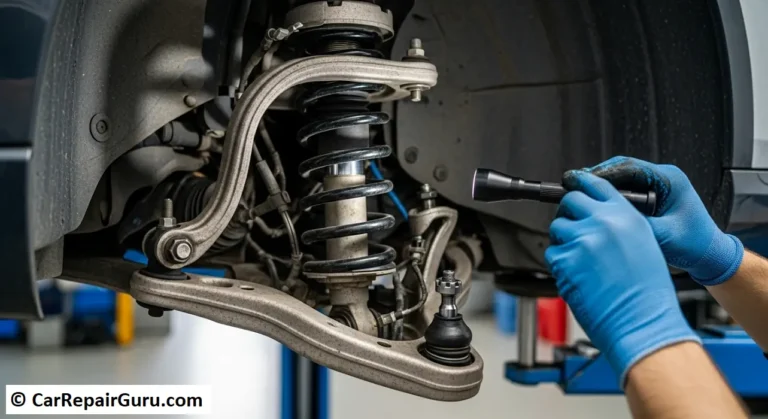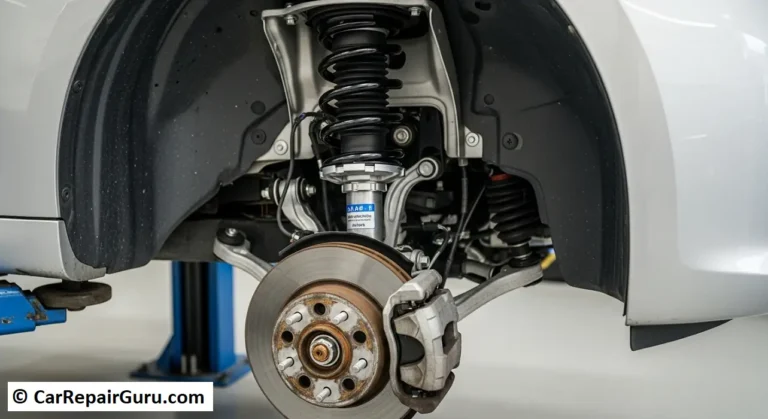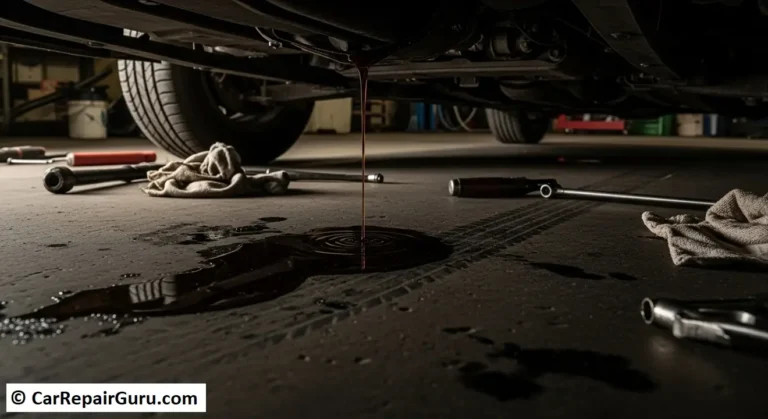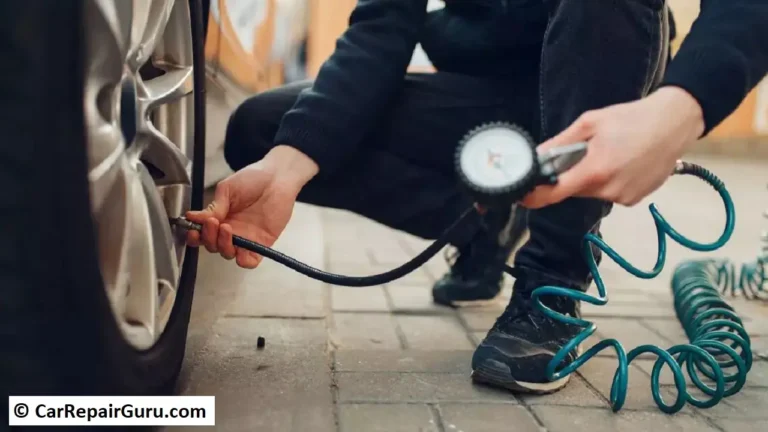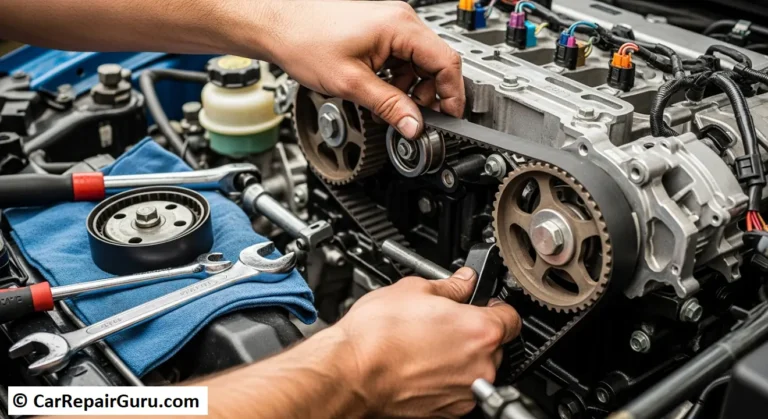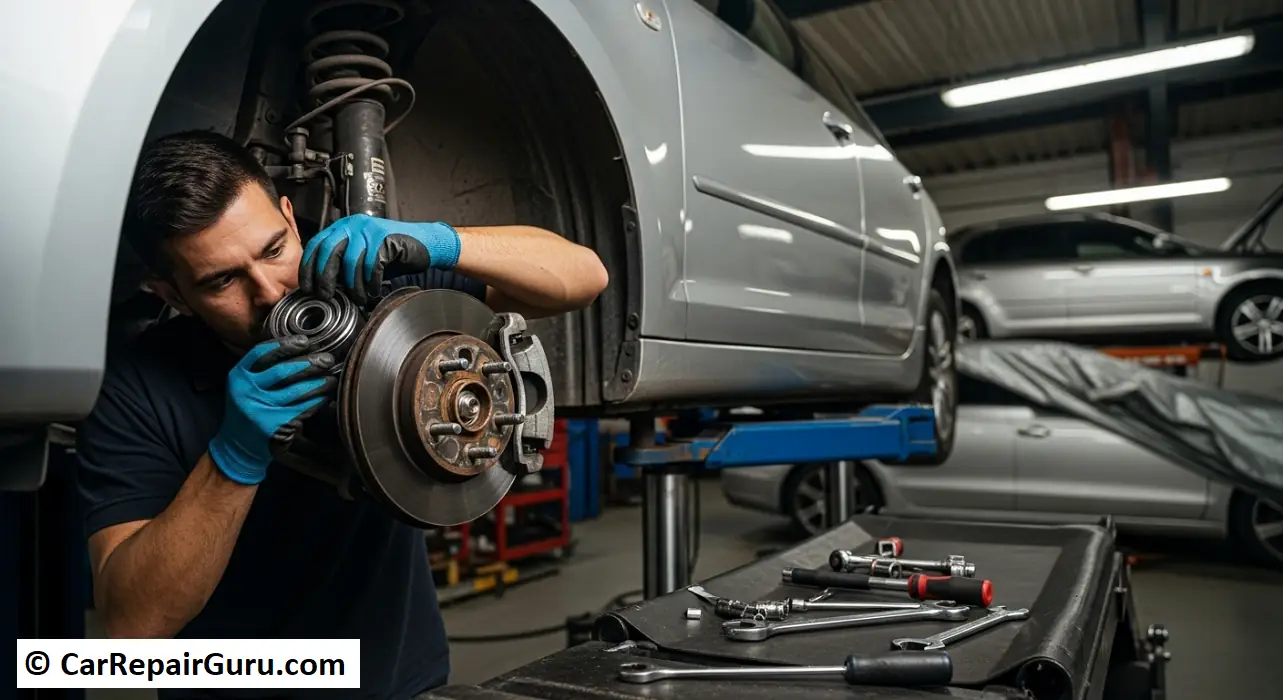
That weird noise started subtly. A faint hum on the highway, almost lost in the sound of the road and wind. But now, it’s a constant companion—a deep, rhythmic growl that gets louder the faster you go. You turn the radio up, but you can still hear it, a clear sign that something in your car is unhappy.
If this sounds familiar, you’re not alone. That persistent humming or grinding noise is one of the most common signs of a failing wheel bearing.
Wheel bearings are one of the most critical safety components on your vehicle, yet they’re often ignored until they start screaming for attention. This guide is here to change that. We’ll demystify everything about the wheel bearings in your car, from identifying the telltale sounds and symptoms to understanding the replacement costs and the serious dangers of putting off the repair.
What Are Wheel Bearings and What Do They Do?
Think of a wheel bearing as the unsung hero of your car’s suspension. At its core, a wheel bearing is a simple but brilliant device: a set of small, incredibly strong steel balls or rollers held within a circular metal housing called a race.
Their primary job is to allow your wheels to spin with almost zero friction.
Imagine trying to spin a heavy car wheel on a fixed axle—it wouldn’t work. The bearing sits inside the wheel hub assembly, providing a smooth, low-friction surface for the wheel to rotate around the stationary axle. This allows for a smooth ride and ensures your wheels turn freely, mile after mile.
The Modern Wheel Hub Assembly
On most cars built in the last 20 years, you won’t find a simple, standalone bearing. Instead, manufacturers use a sealed, non-serviceable unit called a wheel hub assembly. This unit contains the bearing, the hub that the wheel bolts to, and often the mounting point for your brake rotor and the ABS (Anti-lock Braking System) wheel speed sensor. While this makes replacement more straightforward, it also means you typically replace the entire unit rather than just the bearing inside.
5 Telltale Symptoms of a Bad Wheel Bearing
A bad wheel bearing rarely fails suddenly. It usually gives you plenty of warning signs. Learning to recognize these symptoms is key to catching the problem before it becomes a dangerous and expensive failure.
1. The “Humming” or “Growling” Wheel Bearing Noise
This is the classic, number-one symptom. The bad wheel bearing sound is often described as:
- A deep hum or drone that starts around 30-40 mph and gets louder and higher-pitched with speed.
- A grinding or growling noise, especially when turning.
- A sound similar to loud, knobby off-road tires driving on smooth pavement.
The Diagnostic Trick: The noise will often change when you turn. If you make a right turn, weight shifts to the left side of the car. If the humming gets louder, the bad bearing is likely on the left side (and vice-versa). This is a great way to help pinpoint which wheel is the culprit.
2. Steering Wheel Vibration or Pulling
As a bearing wears out, it develops “play” or looseness. This excess movement can translate into a subtle but constant vibration you feel through the steering wheel. The vibration is usually speed-dependent, getting worse as you accelerate. In more severe cases, the car may feel like it’s pulling to one side due to the drag from the failing component.
3. A “Loose” Feeling or Wobbly Wheel
This is a more advanced symptom of a very worn bearing. The steering may feel less precise or “sloppy.” When you hit a bump, you might hear a clunking sound as the loose wheel assembly shifts. This indicates a significant amount of play in the bearing and is a serious safety concern.
4. Uneven Tire Wear
A wheel that is wobbling on a bad bearing won’t roll perfectly straight. This causes the tire to wear down unevenly, often creating “scalloped” or “cupped” patterns on the tread. If your mechanic points out bizarre tire wear during a rotation, a bad wheel bearing should be a prime suspect.
5. ABS Warning Light On
On modern vehicles, the ABS wheel speed sensor is often integrated directly into the wheel hub assembly. As the bearing fails, the excessive play can damage this sensitive sensor or create a gap that prevents it from getting a proper reading. The car’s computer interprets this as a fault and illuminates the ABS light on your dashboard.
What Causes Wheel Bearings to Fail?
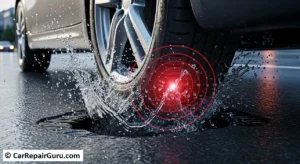
Wheel bearings are designed to last a long time—often over 100,000 miles. But several factors can cut that lifespan short. Understanding the causes of wheel bearing failure can help you protect them.
- Impact Damage: This is the most common killer. Hitting a deep pothole, smacking a curb, or being in a minor accident can send a powerful shock through the bearing, denting the internal races or rollers. This damage creates a rough spot that quickly deteriorates.
- Water and Contaminant Intrusion: Bearings are sealed to keep lubricating grease in and dirt and water out. If this seal is compromised, moisture seeps in, causing rust and breaking down the grease. Road salt and grit act like sandpaper, grinding away at the smooth surfaces.
- Improper Installation: This is a big one for DIY repairs. Press-in style bearings require a hydraulic press for installation. Using a hammer or impact gun can cause microscopic fractures that lead to premature failure.
- Vehicle Modifications: Installing large, heavy aftermarket wheels or using extreme wheel spacers puts a much higher load on the bearings than they were designed for. This added stress can dramatically shorten their life.
- Simple Wear and Tear: Nothing lasts forever. After tens of millions of rotations under thousands of pounds of force, even the best-made bearing will eventually wear out.
How to Check for a Bad Wheel Bearing at Home
If you suspect a bad bearing, you can perform a couple of simple diagnostic tests at home. This can help you confirm the issue before heading to the shop.
Safety First! This check requires lifting your car. Never work under a vehicle supported only by a jack. Always use properly rated jack stands on a flat, level surface and chock the wheels that remain on the ground.
The Wiggle Test
- Safely lift the corner of the car with the suspect wheel off the ground.
- Place your hands at the 12 o’clock and 6 o’clock positions on the tire.
- Try to rock the wheel back and forth by pushing with one hand and pulling with the other.
- Feel for any play, looseness, or a “clunking” sound. A healthy wheel bearing will have virtually zero movement. If you can feel it wiggle, the bearing is bad.
The Spin Test
- With the wheel still in the air, place your hands on the tire and spin it as fast as you can.
- Listen closely and feel for any vibration through the suspension.
- A good bearing will allow the wheel to spin smoothly and silently. A bad bearing will feel rough, gritty, or make an audible grinding noise as it rotates.
Can You Drive with a Bad Wheel Bearing? The Risks Explained
This is a question we hear all the time, and the answer is an emphatic no. Continuing to drive on a failing wheel bearing is not just a bad idea—it’s extremely dangerous.
Here’s why: as the bearing deteriorates, the friction and heat build up exponentially. This can lead to a catastrophic failure where the bearing completely seizes.
- The Worst-Case Scenario: Wheel Separation. If the bearing seizes and breaks apart, the entire wheel and hub assembly can detach from your vehicle while you are driving. The result is an instant and total loss of control, which is often fatal at highway speeds.
- Loss of Steering and Braking Control: Even before it fails completely, a wobbly wheel severely compromises your ability to steer accurately and can cause your brake rotor to wobble, reducing braking effectiveness.
- Costly Collateral Damage: A failing bearing can destroy the axle stub, the steering knuckle, and other expensive suspension components, turning a few-hundred-dollar repair into one that costs thousands.
Wheel Bearing Replacement Cost – A Full Breakdown
The wheel bearing replacement cost can vary dramatically, so it’s helpful to understand what you’re paying for.
Factors That Influence the Cost:
- Vehicle Make and Model: Parts for luxury or European cars (like BMW or Audi) are typically much more expensive than for common domestic or Japanese brands (like Ford or Honda).
- Part Type: A modern bolt-on wheel hub assembly is often more expensive for the part itself, but requires less labor to install. An older-style press-in bearing is cheaper for the part, but the labor is significantly higher because it requires special equipment.
- Drivetrain: Front-wheel-drive cars often have more complex front hub assemblies that are harder to access, increasing labor time.
- Labor Rates: Shop labor rates can range from $80 to over $200 per hour depending on your location and whether you go to a dealership or an independent mechanic.
Average Cost Range:
For a single, bolt-on wheel hub assembly: You can expect to pay between $300 and $800 for parts and labor.
For a single, press-in bearing: The cost is often similar, ranging from $350 to $900, with a larger portion of the bill being labor.
DIY vs. Professional Replacement: What’s Right for You?
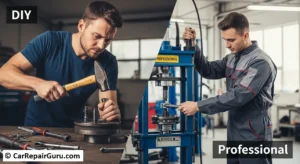
Tempted to save money with a DIY wheel bearing replacement? It’s possible, but you need to be honest about your skills and tools.
The Case for DIY Replacement
You might be a good candidate for a DIY repair if:
- Your car uses a bolt-on wheel hub assembly. This is the most DIY-friendly style.
- You have a solid set of tools, including a good socket set, a breaker bar, and a high-quality torque wrench.
- You are comfortable with major disassembly of your car’s suspension and brakes.
- You live in an area without heavy rust, which can make bolts nearly impossible to remove without professional tools.
When to Call a Professional
You should leave this job to a professional mechanic if:
- Your car has press-in bearings. These require a multi-ton hydraulic press to remove and install without damaging the new part.
- You are not 100% confident in your ability to do the job safely and correctly. This is a critical safety component.
- You don’t own a torque wrench. The axle nut must be torqued to a very specific, high value. Overtightening or under-tightening will cause the new bearing to fail very quickly.
- You encounter heavily rusted or seized components.
Don’t Ignore the Noise
Your car’s wheel bearings are a perfect example of a small part playing a huge role in your safety. That humming or grinding noise is not just an annoyance; it’s a direct warning that a critical component is failing.
By understanding the symptoms, knowing the risks, and acting quickly, you can address the problem before it compromises your safety or leads to a much more expensive repair. If you hear or feel any of the signs we’ve discussed, don’t wait. Get your vehicle inspected immediately. Your safety, and the safety of everyone else on the road, depends on it.
Frequently Asked Questions
How long do wheel bearings last?
A typical wheel bearing is designed to last between 85,000 to 100,000 miles. However, this can be significantly reduced by factors like poor road conditions, impacts, and water intrusion.
Do you have to replace wheel bearings in pairs?
It is not a strict requirement like brake pads. However, it’s often a good idea. The bearings on your car have endured the same mileage and conditions. If one has failed due to wear, the one on the other side is likely not far behind. Replacing them in pairs can save you a future trip to the shop.
What’s the difference between a wheel bearing and a wheel hub?
The wheel bearing is the set of rollers or balls that allows for rotation. The wheel hub is the flange that the bearing fits into and the wheel bolts onto. In modern cars, these two are almost always combined into a single, sealed unit called a wheel hub assembly.
Can a bad wheel bearing affect my brakes?
Absolutely. The excessive play from a bad bearing allows the brake rotor to wobble. This can push the brake caliper piston back into its bore, creating extra travel in your brake pedal and a pulsating sensation when you brake.
